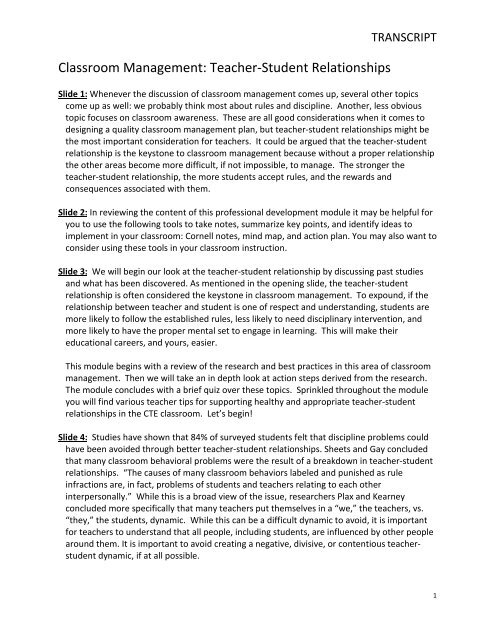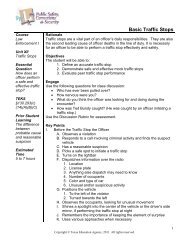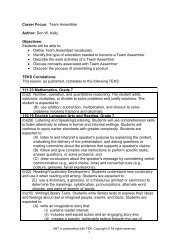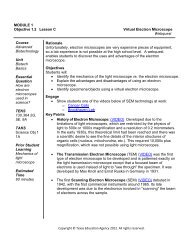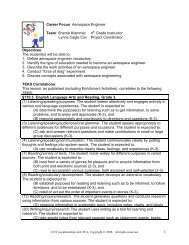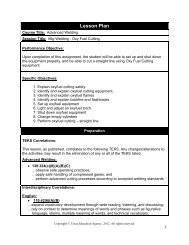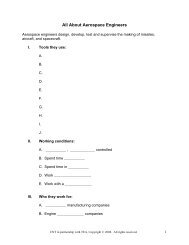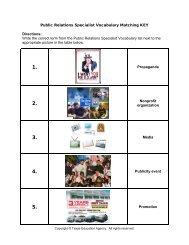Classroom Management: Teacher-Student Relationships
Classroom Management: Teacher-Student Relationships
Classroom Management: Teacher-Student Relationships
You also want an ePaper? Increase the reach of your titles
YUMPU automatically turns print PDFs into web optimized ePapers that Google loves.
<strong>Classroom</strong> <strong>Management</strong>: <strong>Teacher</strong>-<strong>Student</strong> <strong>Relationships</strong>TRANSCRIPTSlide 1: Whenever the discussion of classroom management comes up, several other topicscome up as well: we probably think most about rules and discipline. Another, less obvioustopic focuses on classroom awareness. These are all good considerations when it comes todesigning a quality classroom management plan, but teacher-student relationships might bethe most important consideration for teachers. It could be argued that the teacher-studentrelationship is the keystone to classroom management because without a proper relationshipthe other areas become more difficult, if not impossible, to manage. The stronger theteacher-student relationship, the more students accept rules, and the rewards andconsequences associated with them.Slide 2: In reviewing the content of this professional development module it may be helpful foryou to use the following tools to take notes, summarize key points, and identify ideas toimplement in your classroom: Cornell notes, mind map, and action plan. You may also want toconsider using these tools in your classroom instruction.Slide 3: We will begin our look at the teacher-student relationship by discussing past studiesand what has been discovered. As mentioned in the opening slide, the teacher-studentrelationship is often considered the keystone in classroom management. To expound, if therelationship between teacher and student is one of respect and understanding, students aremore likely to follow the established rules, less likely to need disciplinary intervention, andmore likely to have the proper mental set to engage in learning. This will make theireducational careers, and yours, easier.This module begins with a review of the research and best practices in this area of classroommanagement. Then we will take an in depth look at action steps derived from the research.The module concludes with a brief quiz over these topics. Sprinkled throughout the moduleyou will find various teacher tips for supporting healthy and appropriate teacher-studentrelationships in the CTE classroom. Let’s begin!Slide 4: Studies have shown that 84% of surveyed students felt that discipline problems couldhave been avoided through better teacher-student relationships. Sheets and Gay concludedthat many classroom behavioral problems were the result of a breakdown in teacher-studentrelationships. “The causes of many classroom behaviors labeled and punished as ruleinfractions are, in fact, problems of students and teachers relating to each otherinterpersonally.” While this is a broad view of the issue, researchers Plax and Kearneyconcluded more specifically that many teachers put themselves in a “we,” the teachers, vs.“they,” the students, dynamic. While this can be a difficult dynamic to avoid, it is importantfor teachers to understand that all people, including students, are influenced by other peoplearound them. It is important to avoid creating a negative, divisive, or contentious teacherstudentdynamic, if at all possible.1
TRANSCRIPTIt is important to note that other related studies have sought to identify teachercharacteristics that appeal to students. These studies, while important to the broad field ofclassroom management, did not investigate the dynamics of the teacher-student relationship,which is the focus of this module.Slide 5: Several past studies focusing on relationship dynamics were completed by TheoWubbels in conjunction with others. Wubbels’ studies build on previous studies by TimothyLeary (1957). Wubbels identified two interactions that defined teacher-student relationships.Wubbels describes these as dominance versus submission and cooperation versus opposition.Slide 6: In order to understand Wubbels’ conclusions, we must understand how Wubbelsdefined dominance, submission, cooperation, and opposition. High dominance has thecharacteristics of strong guidance and clarity of purpose in respect to academic andbehavioral issues. <strong>Teacher</strong>s should provide purpose and guidance in respect to studentbehavior and course content. And while these are positive characteristics, high dominancealso carries some negative characteristics which are manifested by a lack of attentiveness anda lack of concern for the interests of the student. On the other end of the scale, highsubmission is characterized by attentiveness and a high concern for student interest whilealso showing a lack of clarity and purpose. The goal for the teacher-student relationship is tofind a balance in this continuum and avoid either extreme.Slide 7: Now that we’ve defined one scale, let’s define cooperation versus opposition. Highcooperation can be observed by showing a high concern for the needs and opinions of othersas well as a desire to function as a member of the team. Negatively, high cooperationproduces a lack of leadership or a fear to act without the input of others. On the other end ofthis scale is extreme opposition. Extreme opposition has no positive characteristics and ismanifested by active antagonism and a desire to destroy the goals and desires of others. Asin the previous slide, either extreme will lead to an unhealthy learning environment.Slide 8: Even though three of the four extremes provide some positive characteristics, theteacher’s goal should be to find the right balance between high dominance or highsubmission, and high cooperation or high opposition. What you see here should be the goalfor any teacher looking for the optimal student-teacher relationship.Slide 9: Wubbels (1999) concluded, “Briefly, teachers should be effective instructors andlecturers as well as friendly, helpful, and congenial. They should be able to empathize withstudents, understand their world, and listen to them. Good teachers are not uncertain,undecided, or confusing in the way they communicate with students. They are not grouchy,gloomy, dissatisfied, aggressive, sarcastic, or quick-tempered. They should also be able to setstandards and maintain control while still allowing students responsibility and freedom tolearn.”2
TRANSCRIPTSlide 10: TIP: Review Wubbels’ conclusion at least once a year, and conduct a self-analysis todetermine your levels of dominance, submission, cooperation, and opposition. Brainstormways you can achieve a healthier balance. Establish improvement goals and track yourprogress!Slide 11: <strong>Teacher</strong>s, like students, evolve over time. In general, teachers tend to begin theircareers as highly cooperative and lacking dominance. Research shows this could be due to alack of experience in leadership positions. However, research shows that after 6 to 10 yearsin the classroom, teachers become more dominant and less cooperative. Wubbels states,“<strong>Teacher</strong>s appear to decline in cooperative behavior and increase in oppositional behavior, achange that negatively affects student attitudes.” Interviewing 712 students in Grades 4, 5,and 6, Lian Chiu and Michael Tulley’s 1997 research supported Wubbels’ findings. <strong>Student</strong>swere presented a survey over teaching styles. The students chose between Wubbelsrules/rewards-punishments, relationship-listening, confronting-contracting, and no preferredapproach. Results showed that students overwhelmingly preferred confronting-contractingbehavior by more than double. Confronting-contracting shows attention to discipline, but notwithout viewing each student individually. It also takes into account students’ needs andpreferences.Slide 12: Brophy and Evertson came to a similar conclusion, supporting a balance of dominanceand cooperation, stating, “<strong>Teacher</strong>s who felt a sense of inner control [and] took personalresponsibility for what went on in their classrooms showed that they were in charge . . . .These teachers also tended to be the ones who were the most successful in obtaining studentlearning gains.”Slide 13: Research by Thompson and Wyatt in 1999 showed staggering results. Their studiesaddressed needs according to student type. Identified needs included homelessness,depression, suicide, violence, eating disorders, alcoholism, attention disorders, sexualorientation, incarceration, poverty, and sexual or physical abuse.The following are some statistics of interest:• On any given night 700,000 students are homeless and 40% of those homeless havechildren• About 8% of adolescents suffer from depression in any given year• More teenage deaths occur from suicide than from any disease• 20% of children are raised in homes where alcoholism is an issue• 1.5 million children have at least one incarcerated parentSlide 14: Addressing student issues is not an option in today’s classroom. It is a reality. Theclassroom may be the only place these children can address their issues. All studies led to asimilar conclusion. <strong>Teacher</strong>s should base their strategies on the needs of each individualstudent.3
TRANSCRIPTSlide 15: TIP: Accommodating student needs is not as difficult or time-consuming as it sounds.From allowing students to use computers and study aids to incorporating peer learningstrategies and oral testing methods, there are lots of simple strategies teachers can use tomodify the learning environment, materials, assignments, and instruction to address theneeds of their students. For suggested modifications, seehttp://www.cte.unt.edu/home/special_pops/modifications.pdf andhttp://www.cte.unt.edu/home/special_pops/modchart.pdfSlide 16: While many staff development programs exist, one in particular focuses on studentteacherrelationships. <strong>Teacher</strong> Expectations and <strong>Student</strong> Achievement, known as TESA, is oneof the most used professional development programs across the country. TESA teaches,“<strong>Teacher</strong>s should ensure that their behaviors are equitable for all students.” This focus onintegrity will lead to students feeling accepted.Slide 17: Now let’s take a look at some techniques to put this theory into action.Action Step One: Use specific techniques to establish an appropriate level of dominance inthe classroom. Dominance can be accomplished in two ways: exhibiting assertive behaviorand establishing clear learning goals.Slide 18: Assertive behavior is the ability to stand up for one’s legitimate rights in ways thatmake it less likely that others will ignore or circumvent them. When using assertive behavior,make sure it is done in a constructive manner that does not attack a student. Constructive,assertive behavior utilizes body language, voice, and persistence. Let’s look more in depth atthese strategies.Slide 19: When using assertive body language, the teacher must make and keep eye contactwith the student. It is important to maintain an upright posture while facing the student, butkeep enough distance so as to not appear threatening.Slide 20: In regards to voice, the teacher must use an appropriate tone, speaking clearly anddeliberately while being firm. In being persistent, it is up to the teacher to never ignore aninappropriate behavior. It is also important to continue a firm response until the appropriatebehavior is displayed; do not allow the student or anyone else to divert your attention untilthe student complies with your request.Slide 21: A second way teachers can establish dominance is by defining clear learning goals. Inorder to create clear learning goals the teacher must be consistent: outlining goals at thebeginning of a unit, providing feedback on goals, continually revisiting goals, and providingfeedback at the end of the unit. Rubrics are a clear way to provide feedback and establishassessment criteria. Remember, dominance impacts not only behavior, but also instructionalcontent.4
TRANSCRIPTSlide 22: TIP: Hand out rubrics to students at the point in the lesson when you assign a project.This way, students will understand ahead of time how they will be evaluated, and can planaccordingly. When you design your rubric, make sure it focuses on a stated learningobjective, uses a range of point values to measure each performance objective, and containsspecific descriptors to indicate the quality of performance at each point value.Slide 23: Now we’ll move on to the next action step.Action Step Two: Use specific behaviors that form a foundation for an appropriate level ofcooperation. <strong>Teacher</strong>s can encourage cooperation by providing flexible learning goals, takinga personal interest in students, practicing equitable and positive classroom behaviors, andresponding appropriately to incorrect student responses.Slide 24: When providing flexible learning goals, teachers in CTE have a unique opportunity toprovide flexible learning goals. Often our content areas are broad enough to allow studentsto focus on specific topics within the curriculum. Allowing students to provide input in theinstructional process could increase students’ cooperation and peak student performance.This conveys to students an interest in their interests.Slide 25: TIP: Allow students to select the subject matter to research, illustrate, or present inclass projects. For example, an Audio/Video Production class might be assigned to shoot a 2-minute commercial as a class project. Allowing students to select the subject of thecommercial (within established guidelines) increases their commitment to the project andtheir interest in creating a quality product.Slide 26: When a teacher takes a personal interest in his or her students, students develop anappreciation for the teacher which can have a positive impact on learning. Personal interestcan be appropriately demonstrated by: (1) talking informally with your students before,during, and after class, (2) greeting your students outside of school, (3) singling out yourstudents in common school areas, (4) being aware of important events in your students’ lives,(5) complimenting your students on their achievements, and (6) meeting your students at thedoor each class day.Slide 27: <strong>Teacher</strong>s should strive to develop equitable and positive classroom behaviors. Goodstrategies to use are making eye contact while moving around the room, making sure to passnear each student, giving credit where credit is due, encouraging students to participate inclass discussions, and providing wait time during question-and-answer sessions.Slide 28: Responding appropriately to incorrect student responses during instruction is anotherkey strategy for fostering cooperation in the classroom. Some suggestions for teachersinclude pointing out what part of the response is correct, allowing students to get help fromtheir peers, giving hints or cues, rephrasing the question, restating the question, providing theanswer and requesting elaboration, and allowing the student the option of deferring aresponse until later if necessary. Mistakes are an important part of the learning process.5
TRANSCRIPTimpulse control, inability to stay seated and work quietly, desire to yell questions andanswers, inability to take turns, and tendency to frequently interrupt other people who arespeaking.Slide 35: The second group of students with attention problems is known as inattentive. Thesestudents fail to show attention to detail, rarely appear to listen, appear unorganized, areforgetful, and seem easily distracted by outside forces.Slide 36: Our fourth type of student is the perfectionist. Often diagnosed with Obsessive-Compulsive Personality Disorder, these students are overly self critical, have low self esteem,fight feelings of inferiority and vulnerability, and feel that they are liked or loved for whatthey do rather than for who they are. For these students, being perfect is the only way togain love, respect, and attention. Be warned, perfectionists are often self-destructive, andtheir perfectionist behaviors, if extreme, can lead to depression or suicide.Slide 37: Our last type of student is the socially inept student. Socially inept students exhibitthe following traits: difficulty making and keeping friends, lack of respect for personal space,excessive talking, making embarrassing remarks, misreading the comments of others, and aninability to fit in with existing social groups.Slide 38: Working with students certainly presents ongoing challenges. Creating positiveteacher-student relationships with student needs in mind is critical for managing a classroom.Remember to balance the appropriate levels of dominance and cooperation whilemaintaining an interest in the students as individuals. Developing appropriate teacherstudentrelationships will contribute to a positive and healthy classroom environment whereall students can engage in learning.Slide 39: TIP: Spend some time reflecting on the five categories of students presented. Do younow or have you in the past fit into any of these categories? How would you have wantedyour teachers to create and maintain relationships with you?Slide 40: To read more on this topic, check out <strong>Classroom</strong> <strong>Management</strong> That Works by RobertMarzano.Slide 41: Let’s look at some review questions to review some of the key points. Try to answerthe question on your own before advancing to the next slide for the correct answer.Question 1: When developing effective teacher-student relationships is it more important topossess high dominance or high cooperation?Slide 42: Answer: Neither. <strong>Teacher</strong>s should strive for moderate levels of dominance andcooperation.7
TRANSCRIPTSlide 43: Question 2: True or False: <strong>Teacher</strong>s can have effective relationships with students ifthey ignore student issues.Slide 44: Answer: False. Understanding student issues is an integral part of forming effectiveteacher-student relationships.Slide 45: Question 3: True or False: Fostering effective teacher-student relationships requiresteachers to exhibit high cooperation, high opposition, high dominance, and high submissioncharacteristics.Slide 46: Answer: False. Extreme or high opposition shows no positive influence on effectiveteacher-student relationships.Slide 47: Question 4: True or False: <strong>Student</strong>s should be viewed as unique individuals.Slide 48: Answer: True. Each student enters your classroom with a unique combination ofpersonality traits and different experiences.Slide 49: Question 5: True or False: Greeting students by name as they enter the classroomhas a positive effect on the teacher-student relationship?Slide 50: Answer: True. Greeting students by name shows interest and caring, and supportsthe value of each individual in the classroom.Slide 51: Working with students certainly presents on-going challenges. Creating positiveteacher-student relationships with student needs in mind is critical for managing a classroom.As Dr. Haim Ginott states, “I've come to the frightening conclusion that I am the decisiveelement in the classroom. It's my daily mood that makes the weather. As a teacher, I possessa tremendous power to make a child's life miserable or joyous. I can be a tool of torture or aninstrument of inspiration.”8


